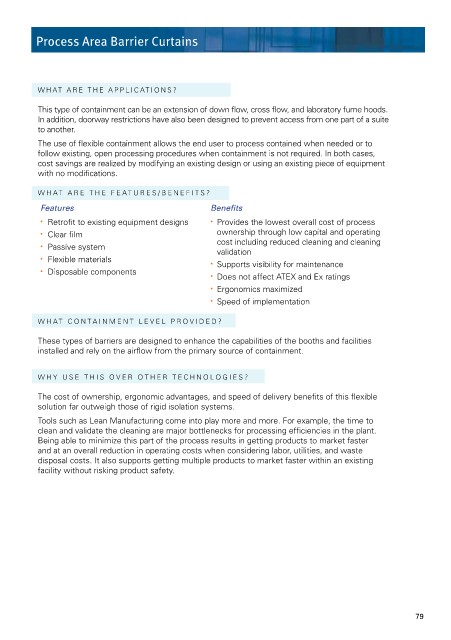Page 1546 - Flipbook_SolidDesignSoutheast2020
P. 1546
Process Area Barrier Curtains
WHAT ARE THE APPLICATIONS?
This type of containment can be an extension of down flow, cross flow, and laboratory fume hoods.
In addition, doorway restrictions have also been designed to prevent access from one part of a suite
to another.
The use of flexible containment allows the end user to process contained when needed or to
follow existing, open processing procedures when containment is not required. In both cases,
cost savings are realized by modifying an existing design or using an existing piece of equipment
with no modifications.
WHAT ARE THE FEATURES/BENEFITS?
Features Benefits
• Retrofit to existing equipment designs • Provides the lowest overall cost of process
• Clear film ownership through low capital and operating
cost including reduced cleaning and cleaning
• Passive system validation
• Flexible materials
• Supports visibility for maintenance
• Disposable components
• Does not affect ATEX and Ex ratings
• Ergonomics maximized
• Speed of implementation
WHAT CONT AINMENT LEVEL PROVIDED?
These types of barriers are designed to enhance the capabilities of the booths and facilities
installed and rely on the airflow from the primary source of containment.
WHY USE THIS OVER OTHER TECHNOLOGIES?
The cost of ownership, ergonomic advantages, and speed of delivery benefits of this flexible
solution far outweigh those of rigid isolation systems.
Tools such as Lean Manufacturing come into play more and more. For example, the time to
clean and validate the cleaning are major bottlenecks for processing efficiencies in the plant.
Being able to minimize this part of the process results in getting products to market faster
and at an overall reduction in operating costs when considering labor, utilities, and waste
disposal costs. It also supports getting multiple products to market faster within an existing
facility without risking product safety.
79

